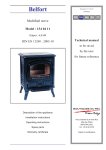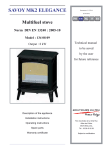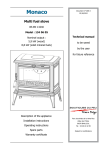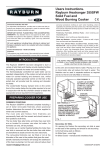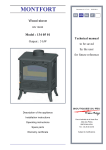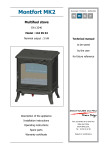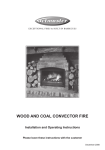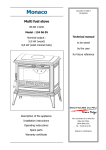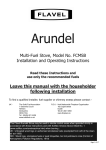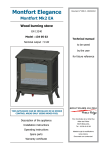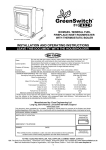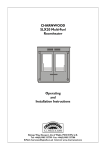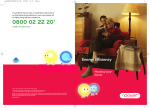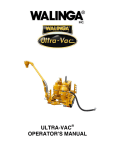Download Monaco 134 06 05 Operating instructions
Transcript
Monaco Document n° 1245-1 ~ 08/11/2007 Multifuel stove DIN EN 13240 : 2005-10 model : 134 06 02 Output : 6 kW Technical manual to be saved by the user for future reference STAUB FONDERIE Description of the appliance Installation instructions Operating instructions Spare parts Warranty certificate SARL with the capital of 6 359 540 , Head Office Address 2, rue Saint Gilles 68230 TURCKHEIM RCS Colmar SIREN 444 881 953 Address Administration and manufacturing BP 73 59660 MERVILLE (FRANCE) Telephone : 00 333 28 43 43 00 Fax : 00 333 28 43 43 99 Subject to modifications. “MONACO” - model : 134 06 02 FRANCO BELGE congratulates you on your choice. FRANCO BELGE, guarantees the quality of its appliances and is committed to meet its customers’ needs. FRANCO BELGE, which can boast a 80-year experience in the industry of heating devices, uses state-of-the-art technologies to design and manufacture its whole range of products. This document contains instructions on how to install your appliance and make full use of its functions, both for your comfort and safety. SOMMAIRE Description of the unit . . . . . . . . . . . . . . . . . . . . . . . . . . . . . . . . . . . p. 3 Package . . . . . . . . . . . . . . . . . p. 3 Appliance description . . . . . . . . . . p. 3 Specifications . . . . . . . . . . . . . . p. 3 Operating principle. . . . . . . . . . . . p. 3 Installation instructions . . . . . . . . . . . . . . . . . . . . . . . . . . . . . . . . . . p. 4 Warning to the user . . . . . . . . . . . p. 4 Flue . . . . . . . . . . . . . . . . . . . . p. 5 Location of the unit . . . . . . . . . . . p. 4 Chimney connector . . . . . . . . . . . p. 6 Mounting the flue collar . . . . . . . . . p. 5 Pre-utilisation check . . . . . . . . . . . p. 6 Smoke exit on the top . . . . . . . . . . p. 5 Maintenance of the Chimney . . . . . . p. 6 Smoke exit at rear . . . . . . . . . . . . p. 5 Instructions for user . . . . . . . . . . . . . . . . . . . . . . . . . . . . . . . . . . . . p. 7 Fuel . . . . . . . . . . . . . . . . . . . . p. 7 Maintenance of the Chimney . . . . . . p. 8 Lighting . . . . . . . . . . . . . . . . . . p. 8 Maintenance of the stove . . . . . . . . p. 8 Operating procedure . . . . . . . . . . . p. 8 Safety advice . . . . . . . . . . . . . . . p. 8 De-ashing . . . . . . . . . . . . . . . . p. 8 Trouble shooting . . . . . . . . . . . . . p. 9 Spare parts . . . . . . . . . . . . . . . . . . . . . . . . . . . . . . . . . . . . . . . . . p. 11 2 Technical manual “1245” “MONACO” - model : 134 06 02 Description of the unit This appliance is designed to burn wood and solid fuel safely WARNING An incorrectly installed stove can cause serious accidents. We recommend this appliance is installed by a competant qualified engineer and serviced annually. 1 Description of the unit 1.1 Package ANTHRACITE Efficiency . . . . . . . . . . . . . . . . % Co (13% O2) . . . . . . . . . . . . . . % Flue mass gas temperature . . . . . °C Combustible flow . . . . . . . . . . kg/h Loading . . . . . . . . . . . . . . . . kg Refueling interval . . . . . . . . . . . mn • 1 package : Stove 1.2 Specifications Model. . . . . . . . . . . . . . . . . . . Chimney draft required . . . . . . . . Pa Nominal heat output . . . . . . . . . kW Useful firebox dimensions - Width . . . . . . . . . . . . . . . . mm - Depth . . . . . . . . . . . . . . . . mm - Height . . . . . . . . . . . . . . . . mm Logs dimensions Max. length . . . . . . . . . . . . . . cm Ash pan capacity . . . . . . . . . . litre Weight . . . . . . . . . . . . . . . . . kg WOOD Efficiency . . . . . . . . . . . . . . . . % Co (13% O2) . . . . . . . . . . . . . . % Flue mass gas temperature . . . . . °C Fuel rate . . . . . . . . . . . . . . . kg/h Loading . . . . . . . . . . . . . . . . kg Refueling interval . . . . . . . . . . . mn 134 06 02 12 6 73,2 0,111 348 1,4 1,5 65 1.3 Appliance description Multifuel stove - in conformity with DIN EN 13240 : 2005-10 429 240 225 • Intermittent-burning heating appliance. • Detachable flue spigot for rear or top chimney 40 3,24 90 connection. • Front loading door fitted with large refractory glass panel. 75,3 0,362 343 2,6 2 45 • Adjustable primary air for controlling the burning rate. • Large ash-pan. 1.4 Operating principle The “ MONACO ” is designed for operation with the door closed. Heat is mainly diffused by radiation, through the window and body of the appliance. Combustion occurs on the grate, with draught entry through the top of the combustion chamber when using wood and under the grate when using smokeless fuels. # $ ! & & " # ' ' " " ' " ! ! # $ $ Figure 1 - Dimensions in mm Technical manual “1245” 3 “MONACO” - model : 134 06 02 Installation instruction 2 Installation instructions 2.1 Warning to the user from any combustible materials. If the appliance has to be located in an opening, this distance must be extended to a minimum clearance (A) of 450 mm from the pipe or the stove body to any combustible materials. Hearth : The appliance must stand on a fireproof hearth.It is possible to provide a hearth made of non combusible board/sheet material or tiles at least 12 mm thick (C).Constructional hearths should be constructed of solid non combustible material at least 125 mm thick (including the thickness of any non combustible floor under the hearth).The hearth must protrude at least 300 mm in front of the stove and 150 mm each side.Hearths are provided to prevent combustion appliances setting fire to the building fabric and furnishings and to limit the risk of people being accidentally burnt. Therefore, they should be separated from adjacent combustible materials and should be satisfactorily delineated from surrounding floor finishes (carpets etc.) as follows. Combustible material should not be placed under a constructional hearth for a solid fuel appliance within a vertical distance of 250 mm from the upper surface of the hearth, unless there is an airspace of at least 50 mm between the combustible material and the underside of the hearth. Where a superimposed hearth has been placed onto a constructional hearth, combustible material placed on or besid the constructional hearth should not extend under the superimposed hearth by more than 25 mm or closer to the appliance than 150 mm. Ensure that the hearth (superimposed or constructional) is suitably delineated to discourage combustible floor finishes from being laid too close to the appliance, by marking the edges or providing a change of level. Position the appliance on the hearth such that combustible marerial cannot be laid closer to the base of the appliance than : (a) At the front, 300 mm if the appliance is an open fire or stove which an, when opened , be operated as an open fire, or 225 mm in any other case ; (b) At the back and sides, 150 mm or in accordance with the recommendations below which relate to distance All the local and national regulations, and in particular those relating to national and European standards, must be observed when installing the appliance. An incorrectly installed heating appliance can cause serious accidents (chimney fires, burning of plastic insulation materials, in partition walls, etc.).The insulation of both the appliance and the exhaust gas pipe has to be reinforced and done according to the Standards and the Building Regulations for safety reasons. The installation must be carried out according to the Standards and the Building Regulations.Failure to respect the manufacturer’s instructions will invalidate the warranty. The manufacturer’s responsibility shall be limited to the supply of the appliance. 2.2 Location of the unit Ventilation : For satisfactory appliance operation with a natural draught, check that sufficient air for combustion is available in the room. In houses equipped with one VMC (controlled mechanical ventilation), this one aspire and renew the ambient air; in this case, the residence is under slight low pressure and a non-sealable external air intake must be installed in addition to the chimney itself, at least 50cm² in section. Position of the unit : For new installations, select a central position within the house, to provide a good heat distribution around the building. The heat distribution towards the other rooms will be made through the communicating doors. These rooms must be at low pressure or fitted with non-adjustable air registers, placed so that they cannot be obstructed, to encourage circulation of the hot air. Floor and walls : Make sure there are not combustible or covered with combustible material. Otherwise it must necessary to install a non-combustible protection. There must be a clearance of at least 150 mm at each side of the appliance and at the back of the appliance from a non-combustible wall. This distance must be extended to a minimum clearance of 900 mm side and 700 back from any c o m b u s t i b l e materials. This measurement may be reduced to a # minimum gap of 50 mm when the non-combustible wall is at least 200 mm thick. When using a single # wall flue pipe, there must be a clearance (A) of at least three times its diameter (B) * ) # ) # + # ! Figure 2 - Minimum clearances 4 Technical manual “1245” “MONACO” - model : 134 06 02 Installation instruction ! # # " $ $ " ! 1 - Flue collar 2 - Gasket 3 - Blanking plate 4 - Clamp 5 - Back panel 6 - Suppl. flue baffle 1 - Flue collar 2 - Gasket 3 - Blanking plate Figure 3 - Smoke exit on the top 4 - Clamp 5 - Back panel 6 - Suppl. flue baffle Figure 4 - Smoke exit at rear from hearth to walls. Please refer to section J of the Building regulations When using a single wall flue pipe, there must be a clearance (A) of at least 450 mm from any combustible materials (timber mantel, girder). 2.3 Mounting the flue collar The stove is supplied with a connection flue spigot with an inner diameter of 125 mm and an outer diameter of 139 mm. 2.3.1 Smoke exit on the top Figure 3 - Remove the internal baffle. - Fix the sealing rope 2 in the groove and fit the flue spigot 1 and the supplt flue baffle 6. - Ensuring there is a good seal. - Replace the internal baffle - The rear heat shield should not be cut out in this type of installation 2.3.2 Smoke exit at rear Figure 4 WARNING : Do not remove the cast iron top - Remove the internal baffle - Remove the blanking plate and the clamp 3 and 4 from the rear and fix the parts on the top - Fit the sealing rope 2 in the groove on the rear and fix the flus collar with the bolts and washers supplied. - Ensuring there is a good seal. - Suppress the supplt flue baffle 6 - Replace the internal baffle Remove the cut-out in the rear heat shield and re-fit (figure 5). Figure 5 - Cut-out in the rear heat shield 2.4 Flue Existing flue : The chimney must comply with Current Building Regulations. If in doubt, consult your Dealer or local Building Inspector. • The flue must be in good condition and must provide sufficient draught (refer to technical details p. 3). • The flue must be suitable for the installation of fuel burning appliances, otherwise it must necessary to install a tubing. • The flue must be clean. It should be swept to remove soot and dislodge tar deposits. • The flue must be well insulated. If the flue inner wall surfaces are cold, a good thermal draw is impossible causing condensation problems (tar formation etc) to occur. • The flue must be watertight. • The flue must not be shared with other appliances. • The chimney must have a constant cross section. • When the cross-section of the chimney is too large, it has difficulties in obtaining a good draught. Technical manual “1245” 5 “MONACO” - model : 134 06 02 Installation instruction • The chimney must be at least 4.5 m (15 ft) high and be at 40 cm above the ridge of the roof and 8 meters away from any construction. • In case of a flat roof or when the roof gradient is lower than 15°, the stack must be 1,2 m (4 feet) high at least. • The capping must not restrain the draught. • If the chimney has any down draught tendency, due to its position in relation to nearby obstacles, then an anti-down draught cowl must be installed on the chimney or the chimney height must be increased. • If the chimney draught is excessive or irregular, a draught stabilizer (barometric damper) must be installed to the connector pipe it must be visible and accessible. Chimney to be built / New flue : The chimney must comply with Current Building Regulations. If in doubt, consult your Dealer or local Building Inspector. • The appliance must not support the weight of the flue. • It must be distant from any combustible material (walls, cross members) • It must permit easy sweeping. 2.5 Chimney connector • The connection to the flue must be carried out according to local building regulations. • The appliance must be installed as close as possible to the chimney. • The connector pipe must be approved for installation • The connection can be either vertical or horizontal. For horizontal connections, avoid right angle bends. • The join between the connection pipe and the stovepipe, and the flue, must be leak tight. • For the premises equipped with a mechanical controlled ventilation, the airtightness has to prevent the exhauster drawing out the smokes from the exhaust gas pipe. • The connection pipe and any draught stabiliser must have access for cleaning. 2.6 Pre-utilisation check Check that the seals of the smoke-line are in good condition. Check that the door closes correctly. Check that the glass is not damaged. Check that the smoke passages are not obstructed by packaging or removable parts. Check that all removable parts are correctly installed. 2.7 Maintenance of the Chimney Very important : In order to avoid any incident (chimney fire, etc...), maintenance tasks must be carried out regularly. If the appliance is regularly used, the chimney should be swept several times per year, together with the stovepipe connection section. If the chimney catches fire, you must cut off the flue draught, close the doors and windows, hatches and keys and call the Fire Brigade without delay. with combustion products (either 24 ga. Black painted or blued steel or 316 grade 20 ga. Stainless steel or 1 mm vitreous enamelled steel). DO NOT OPEN THE DOOR OF THE APPLIANCE (OR AIR INLET) UNDER ANY CIRCUMSTANCES • Pipe diameter must not be less than the appliance Chimney condition should be checked at least once per year by a professional engineer spigot diameter. # " $ ! ! " 1 - Chimney 2 - Funnel-shape fireproof material. 3 - Non-combustible plate 4 - Access to cleaning 5 - Insulation 6 - Plate not removable and ventilated air. Figure 6 - Chimney connector 6 Technical manual “1245” “MONACO” - model : 134 06 02 Instructions for user 3 Instructions for user The manufacturer will not be responsible for damages on parts of the appliance due to the use of prohibited fuel or due to an alteration of the appliance or its installation. Only use replacement parts supplied by the manufacturer. Don’t run the stove in mild weather with coal : Under certain circumstances (e.g. fog and repeated thaw) the chimney will not draw sufficiently well and thus be at the origin of asphyxia. Awaiting better weather circumstances, don’t use any coal but only wood. At the first lighting, the fire must be progressively increased to allow the various parts to expand normally and to dry up. Note : When the fire is lit for the first time, the stove may give off fumes from the new paint. This is normal but ensure the room is well ventilated during the first few hours of operation. Warning : properly installed and operated this appliance will not emit fumes into the dwelling. Occasional fumes from de-ashing and re-fuelling may occur. Persistent fume emission is dangerous and must not be tolerated. If fume emission does persist : Open doors and windows to ventilate room. Let the fire go out and dispose of fuel from the appliance. Check for flue or chimney blockage, and clean if required. Do not attempt to relight the fire until the cause of the fume emission has been identified and corrected. If necessary seek expert advice. Note : It is recommended to use a fireguard in the presence of children, and also in the presence of old and/or infirm people. 3.1. Fuel This appliance is not an incinerator. Use hard wood logs, which have been cut for at least two years and stored, under a ventilated shelter. Use hardwood that have a higher calorific value per cu metre (Yoke-elm, oak, ash, maple, birch, elm, beech, etc.). Large logs must be split and cut to an useful length, before being stored in a sheltered and ventilated place. • Recommended fuel : The best fuels for use with the Franco Belge “Monaco” are : Seasoned wood. - hard wood logs that have been cut, split and stored for at least two years with a minimum moisture content of 20 % e.g. oak, beech, elm etc. Anthracite – dry steam coal fuels as described in type A – table B2 of the Standard – smokeless fuels along with coalite and anthracite. • Prohibited fuel : Any form of housecoal (bituminous coal) or petroleum based fuels. We do not recommend that unseasoned wood (green wood) is used due to it’s high levels of moisture which will produce tar and in turn can cause the insides of the stove and the lining of the chimney to become coated which in turn could lead to a chimney fire. We do not recommend recovered wood e.g railway sleepers,chipboard, pallets are burned as these have been treated and will product a great deal of pollution to the environment and will overheat the appliance. * * * ) A : Opening/closing the main door B : Air control (secondary air inlet) B1 = Air inlet opened. B2 = Air inlet closed C : Draught control (primary air inlet) D : Tool * , + * We recommend that the wooden operating handle is removed from the door immediately after use and set aside due to the fact that wood is a combustible material. The wooden handle should never be left on a lit appliance Figure 7 - Operating devices Technical manual “1245” 7 “MONACO” - model : 134 06 02 Instructions for user 3.1 Lighting 3.4 Maintenance of the Chimney Figure 7 - Slide the top air control (# C). - Open the front door and lay firelighters or rolled up newspapers on the grate with a reasonable quantity, if necessary, of dry kindling wood. Place 2 or 3 small logs on top. - Light the newspaper or firelighters using a long taper and close the front door. - When the fire is burning fiercely, add further logs of a diameter up to 10 cms. - When the stove body is very hot, close the lower air control (# C). - The burning rate can now be adjusted by moving the top air control to the left (# B). Experience will show you which settings are best for your situation. Very important ! In order to avoid any incident (chimney fire, etc...), maintenance tasks must be carried out regularly. If the appliance is regularly used, the chimney should be swept several times per year, together with the stovepipe connection section. If the chimney catches fire, you must cut off the flue draught, close the doors and windows, hatches and keys and call the Fire Brigade without delay. 3.2 Operating procedure The appliance must function with the door properly closed, the burning rate being controlled in using the secondary air regulation flap (rep. B). Experience will show you which settings are best for your situation. When using smokeless fuels, the secondary air inlet must be closed at all time. DO NOT OPEN THE DOOR OF THE APPLIANCE (OR AIR INLET) UNDER ANY CIRCUMSTANCES. The chimney must be serviced and cleaned by a specialist. 3.5 Maintenance of the stove • The appliance must be cleaned regularly , together with the connecting pipe and the flue pipe. • Open the door and remove all deposits in the firebox and clean the removable fire grate. • Cleaning of the glass door can be done with a soft cloth dampened with water and vinegar or potassium ; this must be done when the appliance is cold ; then rinse with clear water. Do not use abrasive cleaners. The burning rate will be controlled in this case in using the primary air inlet (rep. C). The airwash system works with the top airslide. When the top airslide is full open the system works at its strongest efficiency. The more closed down the airslide is, the less effective the airwash will be (when shut down completely, the airwash system can not function). • The “vitroceramic” glass will resists to temperatures of • Loading the fuel • The appliance must not be used with a flue serving - The door should be opened slowly, avoiding a sudden rush of intake air, so that smoke does not escape into the room. - The logs must be placed on the glowing embers. - For a briskly burning fire, there should always be at least two logs in the fire. The fire will burn better if there are several logs. - For a slower burning fire (for example, at night), select larger logs. - After loading the firebox, close the main door (rep. A, figure 7, page 7). 3.3 De-ashing - Ashes must be removed regularly. - Ashes must never be allowed to pile up to the grate. up to 750 C. Should the glass break due to misuse, it must be replaced by the manufacturer own product. • All the casing parts can be cleaned using a soft cloth either dry, or slightly damp. In case of condensation or water splashes clean the parts before they dry out. • Check that there are no obstructions before relighting after a long period of disuse. several appliances. • Keep the grates ventilation free of any obstructions. 3.6 Safety advice This appliance produces heat and may cause severe burns if touched. The stove may still be HOT even when the fire has burnt out. KEEP CHILDREN AWAY. A FIRE GUARD IS ADVISABLE TO PROTECT CHILDREN, THE ELDERLY AND INFIRM. The grate would not be cool down and could rapidly be damaged. - Empty the ashes when the appliance is cold. - Remove the ash drawer using the tool provided. - Empty the ashes carefully with regard to the live embers. 8 Technical manual “1245” “MONACO” - model : 134 06 02 Instructions for user 3.7 Trouble shooting þ : This sign means that you should ask for a qualified engineer to do the work.. Problem Probable causes - Action Fire difficult to start Fire goes out Wood green, too damp. - Use hard wood logs, which have been cut for at least two years and stored, under shelter. Logs are too big. - To light the fire, use small, very dry twigs. To maintain the fire, use split logs. Poor quality wood. - Use hardwood that have a higher calorific value per cu metre (Yoke-elm, oak, ash, maple, birch, elm, beech, etc.) Air starvation. Insufficient draught. - Open lower spin wheel and top air control lever. þ - Check that the flue is not obstructed, sweep it if necessary - Seek advice from a chimney specialist. Fire burns too quickly. Too much draught. - Ensure that the lower spin wheel is closed - Partially close the top air control lever. Excessive draw. þ Poor quality wood. - Install a draught stabiliser. Consult your Dealer. - Do not continuously burn small wood, sticks, bundles, carpentry offcuts (plywood, pallets), etc. Smokes when lighting up. Flue duct is cold. - Burn paper and kindling wood to increase heat. Room is in decompression. - In houses equipped with mechanical ventilation, partly open a window until the fire is well established. Smokes while burning. Draught is insufficien. þ - Consult a chimney specialist. - Check that the flue is not obstructed, sweep if necessary. Low heat output. Technical manual “1245” Down draught. þ - Install an anti-down draught cowl. Consult your Dealer. Room is in decompression. þ - In houses equipped with Mechanical Ventilation, an outside air intake must be installed for the chimney. - Incorrect Fuels. 9 “MONACO” - model : 134 06 02 Note Note 10 Technical manual “1245” “MONACO” - model : 134 06 02 Spare parts 4 Spare parts When ordering spare parts, specify the stove type and serial number, including the colour index (on the guarantee or identification plate), the name of the part and the part number. Example : Wood stove “ MONACO ”, model 134 06 02, the colour index Y, Main door 331116 EF A = 134 06 02 Y ; B = 134 06 02 P ; C = 134 06 02 L ; D = 134 06 02 E ; E = 134 06 02 J N° Code Description . . . . . . . . . Type . . . . . A . . B . . C . . D . . E . . Qty 1 2 3 4 5 6 7 8 9 10 11 11 11 11 12 13 14 15 16 17 18 19 20 21 22 23 24 25 26 27 28 29 29 29 29 29 30 31 31 31 31 31 32 32 32 32 32 33 33 33 33 33 34 35 36 37 37 100917 101067 101809 102041 102042 134253 134758 142881 149882 158637 161025 161027 161060 161061 162352 179628 181614 181632 181633 105006 188858 189104 207309 216123 224022 228624 237406 237415 259015 262614 270402 300136 300136 300136 300136 300136 300432 301537 301537 301537 301537 301537 303718 303718 303718 303718 303718 303860 303860 303860 303860 303860 306260 307424 309232 310733 310733 Cam pin. . . . . . . . . . 12x20 M7 . . . . A . . B . . C . . D . . E Cam pin . . . . . . . . . . . . . . . . . . . A . . B . . C . . D . . E Ring . . . . . . . . . . . . . . . . . . . . . A . . B . . C . . D . . E Firebrick . . . . . . . . . . . . . . . . . . . A . . B . . C . . D . . E Firebrick . . . . . . . . . . . . . . . . . . . A . . B . . C . . D . . E Bushing. . . . . . . . . . . . . . . . . . . . A . . B . . C . . D . . E Pin. . . . . . . . . . . . . . 4 x16 . . . . . A . . B . . C . . D . . E Gasket . . . . . . . . . . . . . . . . . . . . A . . B . . C . . D . . E Knob . . . . . . . . . . . . . . . . . . . . . A . . B . . C . . D . . E Handle . . . . . . . . . . . . . . . . . . . . A . . B . . C . . D . . E Touch-up paint . . . . . . . . . . . . . . . . . . . . . . . C . . . . . . . . Touch-up paint . . . . . . . . . . . . . . . . . . . . . . . . . . . . . . . E Touch-up paint. . . . . . . . . . . . . . . . . . . . B. . . . . . . . . . . . Touch-up paint . . . . . . . . . . . . . . . . . . . . . . . . . . . D . . . . Descriptive plate . . . . . . . . . . . . . . . A . . B . . C . . D . . E Regulator shaft. . . . . . . . . . . . . . . . A . . B . . C . . D . . E Ceramic rope . . . . . . . . Ø 12 . . . . . A . . B . . C . . D . . E Gasket . . . . . . . . . . . . Ø 6 . . . . . . A . . B . . C . . D . . E Gasket . . . . . . . . . . . . Ø 10 . . . . . A . . B . . C . . D . . E Gasket . . . . . . . . . . . . Ø 15 . . . . . A . . B . . C . . D . . E Ceramic glass . . . . . . 425 X 253 . . . . A . . B . . C . . D . . E Screw . . . . . . . . . . . . 6x22 . . . . . A . . B . . C . . D . . E Back panel . . . . . . . . . . . . . . . . . . A . . B . . C . . D . . E Circulation duct . . . . . . . . . . . . . . . A . . B . . C . . D . . E Ash-pan . . . . . . . . . . . . . . . . . . . A . . B . . C . . D . . E Square . . . . . . . . . . . . . . . . . . . . A . . B . . C . . D . . E Reducing plate . . . . . . . . . . . . . . . . A . . B . . C . . D . . E Reducing plate . . . . . . . . . . . . . . . . A . . B . . C . . D . . E Fixing plate . . . . . . . . . . . . . . . . . . A . . B . . C . . D . . E Heat shield . . . . . . . . . . . . . . . . . . A . . B . . C . . D . . E Air control flap . . . . . . . . . . . . . . . . A . . B . . C . . D . . E Leg . . . . . . . . . . . . . . . . . . . . . . . . . . B. . . . . . . . . . . . Leg . . . . . . . . . . . . . . . . . . . . . . . . . . . . . . . . . D . . . . Leg . . . . . . . . . . . . . . . . . . . . . . A . . . . . . . . . . . . . . . Leg . . . . . . . . . . . . . . . . . . . . . . . . . . . . . C . . . . . . . . Leg . . . . . . . . . . . . . . . . . . . . . . . . . . . . . . . . . . . . . E Base . . . . . . . . . . . . . . . . . . . . . A . . B . . C . . D . . E Door lock. . . . . . . . . . . . . . . . . . . . . . . B. . . . . . . . . . . . Door lock . . . . . . . . . . . . . . . . . . . . . . . . . . . . . . D . . . . Door lock . . . . . . . . . . . . . . . . . . . A . . . . . . . . . . . . . . . Door lock . . . . . . . . . . . . . . . . . . . . . . . . . . C . . . . . . . . Door lock . . . . . . . . . . . . . . . . . . . . . . . . . . . . . . . . . . E Blanking plate . . . . . . . . . . . . . . . . . . . . B. . . . . . . . . . . . Blanking plate. . . . . . . . . . . . . . . . . . . . . . . . . . . . D . . . . Blanking plate . . . . . . . . . . . . . . . . A . . . . . . . . . . . . . . . Blanking plate . . . . . . . . . . . . . . . . . . . . . . . . C . . . . . . . . Blanking plate . . . . . . . . . . . . . . . . . . . . . . . . . . . . . . . E Flue collar . . . . . . . . . . . . . . . . . . . . . . B. . . . . . . . . . . . Flue collar. . . . . . . . . . . . . . . . . . . . . . . . . . . . . . D . . . . Flue collar . . . . . . . . . . . . . . . . . . A . . . . . . . . . . . . . . . Flue collar . . . . . . . . . . . . . . . . . . . . . . . . . . C . . . . . . . . Flue collar . . . . . . . . . . . . . . . . . . . . . . . . . . . . . . . . . E Back wall . . . . . . . . . . . . . . . . . . . A . . B . . C . . D . . E Fuel retainer . . . . . . . . . . . . . . . . . A . . B . . C . . D . . E Wood grate . . . . . . . . . . . . . . . . . . A . . B . . C . . D . . E R. side panel. . . . . . . . . . . . . . . . . . . . . B. . . . . . . . . . . . R. side panel . . . . . . . . . . . . . . . . . . . . . . . . . . . . D . . . . 11 RH RP EF 77 79 EF RH RP EF 77 79 RH RP EF 77 79 RH RP EF 77 79 EF EF RH RP . . . . . . . . . . . . . . . . . . . . . . . . . . . . . . . . . . . . . . . . . . . . . . . . . . . . . . . . . . 01 . 01 . 05 . 02 . 02 . 01 . 01 . 02 . 01 . 01 . 01 . 01 . 01 . 01 . 01 . 02 1,04 m 1,35 m 1,58 m 1,65 m . 01 . 02 . 01 . 02 . 01 . 01 . 01 . 01 . 02 . 01 . 01 . 04 . 04 . 04 . 04 . 04 . 01 . 01 . 01 . 01 . 01 . 01 . 01 . 01 . 01 . 01 . 01 . 01 . 01 . 01 . 01 . 01 . 01 . 01 . 01 . 01 . 01 Technical manual “1245” “MONACO” - model : 134 06 02 Spare parts ! & ! " $ " # " ! ! " % $ " " ! ' ! " % ! " ! ! " ! & ! " & & % ! $ # " " # # ! $ # " " ! ' ' " ! " ' $ # ! # ' ! ! ! ' " & ! % % Figure 8 - Spare parts view Technical manual “1245” 12 “MONACO” - model : 134 06 02 Spare parts A = 134 06 02 Y ; B = 134 06 02 P ; C = 134 06 02 L ; D = 134 06 02 E ; E = 134 06 02 J N° Code 37 37 37 38 38 38 38 38 39 40 41 42 43 43 43 43 43 44 44 44 44 44 45 46 46 46 46 46 47 48 49 50 50 50 50 50 310733 310733 310733 310833 310833 310833 310833 310833 315615 323209 324503 326601 327909 327909 327909 327909 327909 331116 331116 331116 331116 331116 332004 352175 352175 352175 352175 352175 406816 415504 808001 989009 989010 989011 989012 989013 Description . . . . . . . . . Type . . . . . A . . B . . C . . D . . E . . Qty EF 77 79 RH RP EF 77 79 RH RP EF 77 79 RH RP EF 77 79 RH RP EF 77 79 60 ED R. side panel . . . . . . . . . . . . . . . . . A . . . . . . . . . . . . . . . R. side panel . . . . . . . . . . . . . . . . . . . . . . . . C . . . . . . . . R. side panel . . . . . . . . . . . . . . . . . . . . . . . . . . . . . . . . E L. side panel . . . . . . . . . . . . . . . . . . . . . B. . . . . . . . . . . . L. side panel . . . . . . . . . . . . . . . . . . . . . . . . . . . . D . . . . L. side panel . . . . . . . . . . . . . . . . . A . . . . . . . . . . . . . . . L. side panel . . . . . . . . . . . . . . . . . . . . . . . . C . . . . . . . . L. side panel . . . . . . . . . . . . . . . . . . . . . . . . . . . . . . . . E Air duct . . . . . . . . . . . . . . . . . . . . A . . B . . C . . D . . E Flue baffle . . . . . . . . . . . . . . . . . . A . . B . . C . . D . . E Sealing plate . . . . . . . . . . . . . . . . . A . . B . . C . . D . . E Suppl. flue baffle . . . . . . . . . . . . . . . A . . B . . C . . D . . E Ash pan guide . . . . . . . . . . . . . . . . . . . . B. . . . . . . . . . . . Ash pan guide . . . . . . . . . . . . . . . . . . . . . . . . . . . D . . . . Ash pan guide . . . . . . . . . . . . . . . . A . . . . . . . . . . . . . . . Ash pan guide . . . . . . . . . . . . . . . . . . . . . . . . C . . . . . . . . Ash pan guide . . . . . . . . . . . . . . . . . . . . . . . . . . . . . . . E Main door . . . . . . . . . . . . . . . . . . . . . . B. . . . . . . . . . . . Main door . . . . . . . . . . . . . . . . . . . . . . . . . . . . . . D . . . . Main door. . . . . . . . . . . . . . . . . . . A . . . . . . . . . . . . . . . Main door . . . . . . . . . . . . . . . . . . . . . . . . . . C . . . . . . . . Main door . . . . . . . . . . . . . . . . . . . . . . . . . . . . . . . . . . E Air duct . . . . . . . . . . . . . . . . . . . . A . . B . . C . . D . . E Top plate . . . . . . . . . . . . . . . . . . . . . . . B. . . . . . . . . . . . Top plate . . . . . . . . . . . . . . . . . . . . . . . . . . . . . . D . . . . Top plate . . . . . . . . . . . . . . . . . . . A . . . . . . . . . . . . . . . Top plate . . . . . . . . . . . . . . . . . . . . . . . . . . C . . . . . . . . Top plate . . . . . . . . . . . . . . . . . . . . . . . . . . . . . . . . . . E Clamp . . . . . . . . . . . . . . . . . . . . A . . B . . C . . D . . E Poker . . . . . . . . . . . . . . . . . . . . . A . . B . . C . . D . . E Hand tool . . . . . . . . . . . . . . . . . . . A . . B . . C . . D . . E Complete door . . . . . . . . . . . . . . . . A . . . . . . . . . . . . . . . Complete door . . . . . . . . . . . . . . . . . . . . B. . . . . . . . . . . . Complete door . . . . . . . . . . . . . . . . . . . . . . . C . . . . . . . . Complete door . . . . . . . . . . . . . . . . . . . . . . . . . . . D . . . . Complete door . . . . . . . . . . . . . . . . . . . . . . . . . . . . . . . E Technical manual “1245” . . . . . . . . . . . . . . . . . . . . . . . . . . . . . . . . . . . . . . . . . . . . . . . . . . . . . . . . . . . . . . . . . . . . . . . . 01 01 01 01 01 01 01 01 01 01 01 01 01 01 01 01 01 01 01 01 01 01 01 01 01 01 01 01 01 01 01 01 01 01 01 01 13 § Guarantee certificate § § Legal guarantee our “Guarantee Inspection” Department. Carriage and labour is at the user’s cost. Moreover, if the repair or replacement of parts covered by the guarantee is found to be too costly vis-à-vis the price of the appliance, the decision to replace or repair the appliance will be taken by the vendor. Our guarantee is for 2 (two) years for all appliances, with the exception of closed combustion fireplace and inserts for which our guarantee is 5 (five) years excluding the following: The specifications, dimensions and information shown on our documents are provided for information purposes only and under no circumstances are binding upon the vendor. With the aim of constantly improving our equipment, all modifications considered as necessary by our departments may be made without notice. The provisions of the present guarantee certificate are not excluding or limiting the owner of the equipment’s rights, concerning the legal guarantee regarding faults or hidden vices which applies in all circumstances, in the conditions detailed in articles 1641and following of the civil code, and in the country in which the equipment was purchased. 1) Indicator lights, fuses, electrical elements and fans. 2) Parts subject to wear or in contact with high temperatures namely: soles and burner grills, bottom plates baffles, ash pans, paintwork and surface treatments for decorative parts. Also excluded from this guarantee are seals and windows. 3) Any damage which may result from the use of the appliance with a fuel other than that stipulated in our instructions. 4) Damage occurring to parts caused by elements outside the appliance (down draught, storm damage, damp, abnormal pressure or vacuum, heat shocks, etc.). 5) Damage to electrical parts caused by plugging in and using the appliance on a mains system, the voltage of which (measured at the entrance to the appliance) is 10% above or below the nominal voltage of 220 V. § Contractual guarantee Our equipment is guaranteed against faults and hidden vices subject to the following conditions: 1) Installation and adjustment of the device by a professional installer. 2) Observance of the instructions provided in our technical documents and our installation/adjustment instructions. 3) The installation, use and maintenance of the device carried out in conformity with the applicable standards and legislation, and with the indications provided in the technical instructions accompanying the device. § Exclusion of liability In the case of a product manufactured at the client’s request, under no circumstances may we, as a subcontractor, be considered liable vis-a-vis the client or third parties for defects arising from the installation or a design fault with the item in question. This guarantee covers the replacement, in our factory, of parts recognised as being defective from the outset by * Name and address of the installer : _ _ _ _ _ _ _ _ _ _ _ _ _ _ _ _ _ _ _ _ _ _ _ _ _ _ _ _ _ _ _ _ _ _ _ _ _ _ _ _ _ _ _ _ _ _ _ _ _ _ _ _ _ _ _ _ _ _ _ _ _ _ _ _ _ _ _ _ _ _ _ ( Telephone : _ _ _ _ _ _ _ _ _ _ _ _ _ _ _ _ _ _ _ _ _ _ _ _ _ _ _ _ _ _ _ _ _ _ _ _ _ * Name and address of the customer : _ _ _ _ _ _ _ _ _ _ _ _ _ _ _ _ _ _ _ _ _ _ _ _ _ _ _ _ _ _ _ _ _ _ _ _ _ _ _ _ _ _ _ _ _ _ _ _ _ _ _ _ _ _ _ _ _ _ _ _ _ _ _ _ _ _ _ _ _ _ Date of installation : Model of the appliance : Color : q Y Serial number : __ __ / __ __ /__ __ __ __ ❑ 134 06 02 q P q L q E q J ___ ___ ___ ___ ___ ___ • This certificate has to be completed and kept carefully. In case of claims, send a copy of this to : STAUB FONDERIE, BP 73, 59660 MERVILLE, FRANCE.














